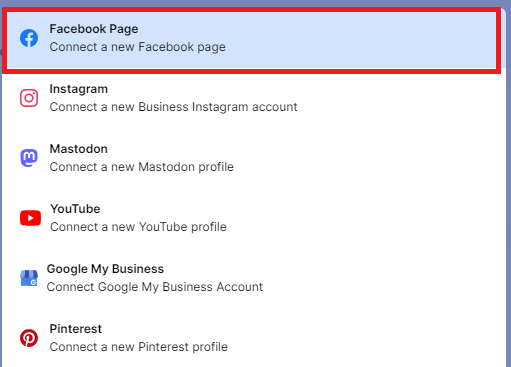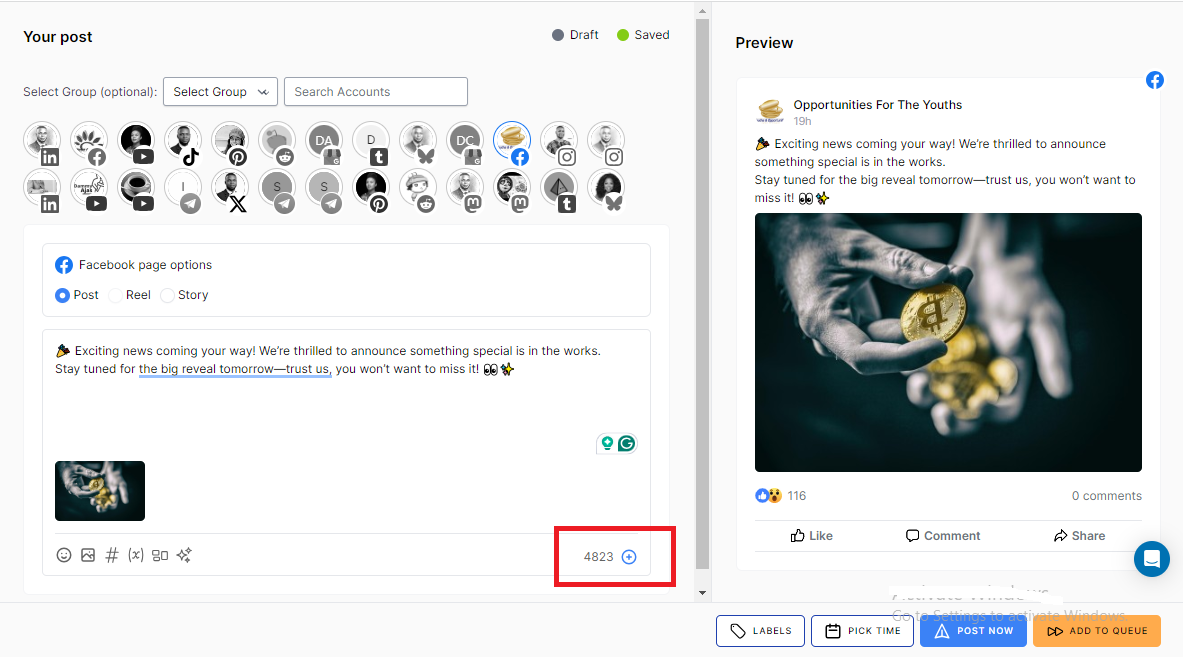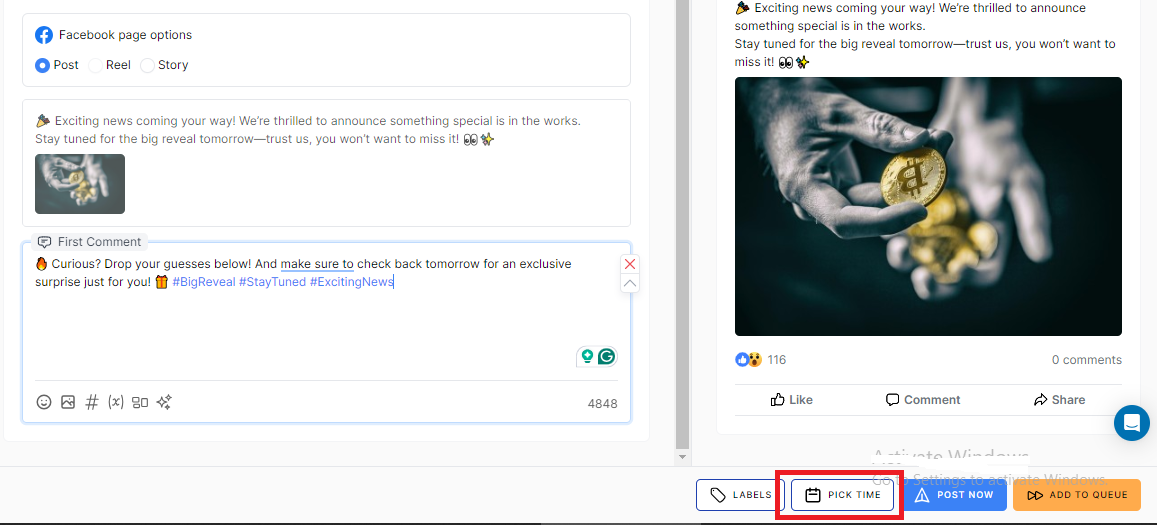How to Schedule a First Comment on Facebook

Ever wonder why everyone’s racing to drop the first comment on Facebook?
For years, being the first to comment on a post has been a subtle power move on social media. It’s a way to grab attention and stand out in the flood of engagement, especially on accounts with high interaction. But how can you make sure your comment lands first when timing is everything?
In this post, we are going to be showing you why that first comment matters and how you can take control by scheduling it strategically on Facebook.
Ready to up your engagement game? Let’s show you how to schedule a first comment on Facebook!
Table of Contents
Why Do First Comments Matter?
The first comment on a Facebook post is more than just a space to engage – it’s a key driver of visibility and interaction.
It sets the tone for the conversation, sparks further interaction, and signals to Facebook’s algorithm that the post is worth paying attention to.
This can help boost the post’s reach, as more engagement typically leads to greater visibility in users’ feeds.
An important trend on Facebook is that posts with direct links often see lower engagement because the platform’s algorithm tends to favor content that keeps users within Facebook.
Studies have shown that posts without links have up to 18% higher engagement rates and 25% more impressions than those with links.
This is why many marketers now place important links in the first comment rather than in the post itself – allowing them to boost engagement without sacrificing visibility.
The first comment also provides an opportunity to add valuable context, give additional insights, or include a call to action (like a link or special offer).
This simple strategy can significantly increase your post’s effectiveness, making it a key tactic for maximizing your impact on Facebook.
By leveraging the first comment strategically, you can align with Facebook’s algorithm and engage your audience more effectively.
Scheduling First Comments on Facebook
So, why should you schedule the first comment on your Facebook posts? Simple – timing matters.
By scheduling the first comment, you can align it perfectly with the moment your post goes live, ensuring it drives engagement right from the start.
Whether you’re adding a crucial link, offering extra context, or nudging your audience toward a call to action, scheduling allows you to plan ahead and optimize your content strategy.
This approach is especially useful during non-peak hours or when you’re too busy to monitor your posts.
Scheduling ensures your comments are posted at the right time, even if you’re away, helping you maintain a consistent presence on Facebook.
Plus, it ensures that your comment is ready to capture attention and boost your post’s visibility exactly when you need it.
So, if you belong to the group of people who are still confused about how to schedule a first comment on Facebook, let’s show you how.
How to Schedule a First Comment on Facebook – Step By Step
Unlike what many people thought; you don’t have to manually add the first comment to your Facebook posts.
This can be overwhelming when you need to make several posts on your page or you’re managing many Facebook pages and so have to schedule multiple posts in advance.
The good news, however, is that you can schedule the first comment to go live right at the same time your post is published.
You won’t have to worry about having someone else’s comment come before your own. Immediately after the post is published, the first comment will be published together with it.
To schedule a first comment on Facebook, below are the steps you will need to follow:
Step 1: Log into OnlySocial and connect your Facebook page
The first thing to do is to connect your Facebook page or profile to OnlySocial to be able to schedule your content – whether posts or comments.
So, log in to your OnlySocial account. If you don’t already have one, quickly create an account on the platform.
Now, click on the ‘Account’ tab on the sidebar, then on ‘Add Account‘. choose Facebook from the options, and then follow the prompts to connect your Facebook profile to OnlySocial.
Step 2: Create your Facebook post
Click on ‘Create post’ in the top left corner to start creating your Facebook post. Choose the Facebook profile you want to schedule to.
If you have multiple Facebook accounts connected to OnlySocial, you can choose to post to as many of them as you can – just select the ones you want to create and schedule the post to.
Use the text box on the page to write your post. You can make it even more engaging by using the corresponding options below the text field to add images or videos to your post.
Also, don’t forget to include the right keywords and hashtags in your post.
Step 3: Write the first comment
To compose your first comment, click on the + icon at the bottom of the text field. This will open another text field where you can write your first comment.
Step 4: Schedule your post with the comment
Next is to schedule the post alongside the comment. So, click on ‘Pick time’ at the bottom of the page and choose the date and time you would like your post and comment to be published on your Facebook profile.
Once you have chosen your desired time, hit the ‘Schedule’ button at the bottom to schedule the post and comment for a later time.
Best Practices for Scheduling First Comments on Facebook
Here are some essential tips to help you make the most of scheduling first comments on Facebook:
#1: Align Your Comment with Your Post’s Objective
The first comment should complement your post and align with its main goal. Whether you’re driving traffic to a website, sharing additional insights, or encouraging discussion, make sure the comment reinforces the message of your post and adds value.
For example, if your post is promoting a blog, the first comment could include a link to the full article with a compelling call to action.
#2: Time It Strategically
Scheduling the first comment to appear shortly after your post goes live is crucial. Aim to post it within the first few minutes of your post being published to encourage early engagement.
This signals to Facebook’s algorithm that the post is generating interaction, which can boost its visibility in users’ feeds. Luckily, when you schedule a first comment on Facebook with OnlySocial, your comment will be published at the same time the scheduled post is published.
#3: Use the Comment to Add Value
Instead of just restating what’s in the post, use the first comment to expand on the topic. You could provide a behind-the-scenes look, share a related tip, or ask a question to spark conversation.
Offering additional value encourages users to engage with both the post and the comment, boosting interaction rates.
#4: Include a Call to Action (CTA)
The first comment is the perfect place for a strong call to action. Whether you’re asking your audience to visit a link, join a discussion, or participate in a poll, make your CTA clear and actionable.
By placing it in the first comment, you avoid cluttering the post while still driving engagement.
#5: Leverage Hashtags Wisely
If you’re using hashtags to boost discoverability, consider placing them in the first comment rather than the post itself.
This keeps the post clean and focused while still allowing it to benefit from the reach hashtags provide. Be sure to use hashtags relevant to your content and audience.
#6: Track and Optimize
After scheduling your first comments, monitor how they perform. Pay attention to which types of comments generate the most engagement and tweak your strategy based on the data.
Over time, you’ll get a better sense of what resonates with your audience and can adjust your comments to maximize effectiveness.
By following these best practices, you can ensure that your first comment on Facebook posts drives meaningful engagement and boosts the visibility of your content.
Final Note
In today’s fast-paced social media environment, timing and strategy are everything.
Scheduling your first comment on Facebook can be a game changer, helping you boost engagement, drive traffic, and maintain a consistent presence without the stress of manual posting.
Now that you know how and why to schedule a first comment on Facebook, it’s time to put this strategy into action and maximize your reach.
Let OnlySocial help you stay ahead, so you can focus on creating great content while the tool handles the rest.
FAQs
Can I post links in first comments on Facebook?
Yes, you can definitely post links in the first comment on Facebook. In fact, placing links in the comments rather than the main post is a smart strategy to avoid lower reach since Facebook’s algorithm tends to deprioritize posts with external links. This helps keep your post more visible while still driving traffic to your link.
Can I schedule more than one comment?
Yes, with scheduling tools like OnlySocial, you can schedule multiple comments. This allows you to add additional context or follow-up information at different intervals, making it easier to manage your interactions and keep conversations flowing.
How long after my post is published will my comment be published?
You can schedule your comment to be published almost immediately after your post goes live, or you can set a specific delay if you prefer. Most scheduling tools will let you choose the exact timing, ensuring your comment appears at the optimal moment for engagement.
Can I schedule comments on other social media platforms?
Yes, OnlySocial allows you to schedule comments on both Facebook and Instagram. This makes it easier to manage your engagement strategy across multiple platforms, ensuring your comments are timed perfectly to boost interaction.
Can I schedule more than one comment?
No, you can only schedule a first comment on Facebook. However, that’s often enough to get the job done. The first comment can serve as the perfect place to include a call to action, share additional insights, or drop a link, driving immediate engagement and interaction with your post.
How long after my post is published will my comment be published?
Your scheduled comment will be published immediately when the post goes live. This ensures that your comment is perfectly timed to drive engagement right from the start.




